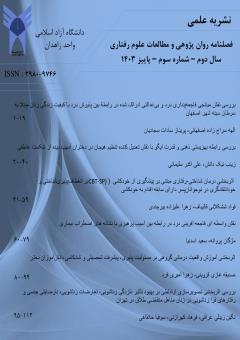نقش واسطه ای فاجعه آفرینی درد در رابطه بین آسیب پرهیزی با نشانه های اضطراب بیماری
محورهای موضوعی : روانشناسی
مژگان پروانه
1
![]() ,
سعید اسدنیا
2
,
سعید اسدنیا
2
1 - دانشجوی کارشناس ارشد روانشناسی بالینی، واحد ارومیه، دانشگاه آزاد اسلامی، ارومیه
2 - دکتری روانشناسی، دانشکده علوم تربیتی و روانشناسی، دانشگاه تبریز
کلید واژه: آسیبپرهیزی, اختلال اضطراب بیماری, فاجعهآفرینی درد, دانشجویان.,
چکیده مقاله :
اضطراب بیماری اختلالی شایع، ناتوان کننده و پرهزینه است. هدف پژوهش حاضر بررسی نقش واسطه ای فاجعهآفرینی درد در رابطه بین آسیب پرهیزی و نشانه های اختلال اضطراب بیماری در دانشجویان بود. روش پژوهش از نوع توصیفی - همبستگی و جامعهی آماری پژوهش شامل کلیه دانشجویان دانشگاه آزاد اسلامی واحد ارومیه در نیمسال دوم تحصیلی 1403-1402 بود. 240 نفر از دانشجویان به روش نمونهگیری خوشهای چندمرحلهای اانتخاب و به پرسشنامههای استاندارد فاجعهآفرینی درد (سالیوان و همکاران، 1995)، اضطراب سلامتی (سالکویسکیس و همکاران، 2002) و سرشت و منش (کلونینجر،1994) پاسخ دادند. دادهها به روش همبستگی پیرسون و مدل سازی معادلات ساختاری و با بهره گیری از نسخه 26 نرم افزار SPSS و نسخه 24 نرم افزار Amosتحلیل شد. یافتهها نشان داد اثر مستقیم آسیب پرهیزی (074/0>p ,128/0=β) بر نشانههای اضطراب بیماری معنی دار نیست؛ اما اثر مستقیم آسیب پرهیزی (001/0>p ,290/0=β) بر فاجعهآفرینی درد و فاجعهآفرینی درد (001/0>p ,296/0=β) بر اضطراب بیماری معنی دار است. همچنین نتایج نشان داد که فاجعه آفرینی درد در رابطه بین آسیب پرهیزی با اضطراب بیماری دانشجویان نقش میانجی ایفا می¬کند (01/0>p ,014/0=β). مدل فرضی پژوهش نسبت به مدلهای جایگزین از برازش بهتری برخوردار بود و این نتایج میتوانند به درک بهتر از عوامل مؤثر بر اضطراب بیماری و ارائه راهکارهای درمانی کمک کنند. یافتههای این پژوهش چهارچوب مناسبی برای سببشناسی اختلال اضطراب بیماری فراهم میآورد و میتواند در طراحی و اجرای مداخلات درمانی مبتنی بر کاهش آسیب پرهیزی و فاجعهآفرینی درد برای بهبود نشانههای این اختلال مورد استفاده قرار گیرد.
Illness anxiety is a common, debilitating, and costly disorder. The aim of the present study was to examine the mediating role of pain catastrophizing in the relationship between harm avoidance and the symptoms of illness anxiety disorder among students. The research method was descriptive-correlational, and the statistical population included all students of the Islamic Azad University, Urmia Branch, during the second semester of the academic year 2023-2024. 240 students were selected by multi-stage cluster sampling method and answered the standard questionnaires of pain catastrophizing (Sullivan et al., 1995), health anxiety (Salkovskis et al., 2002) and Temperament and Character (Kloninger, 1994). Data were analyzed using Pearson correlation and structural equation modeling with SPSS version 26 and Amos version 24. The findings indicated that the direct effect of harm avoidance (p < 0.074, β = 0.128) on illness anxiety is not significant; however, the direct effect of harm avoidance (p < 0.001, β = 0.290) on pain catastrophizing and pain catastrophizing (p < 0.001, β = 0.296) on illness anxiety is significant. Additionally, the results showed that pain catastrophizing plays a mediating role in the relationship between harm avoidance and illness anxiety among students (p < 0.01, β = 0.014). The proposed model of the study had a better fit compared to alternative models, and these results can contribute to a better understanding of the factors influencing illness anxiety and the development of therapeutic strategies. The findings provide a suitable framework for the etiology of illness anxiety disorder and can be utilized in designing and implementing therapeutic interventions aimed at reducing harm avoidance and pain catastrophizing to improve the symptoms of this disorder.


